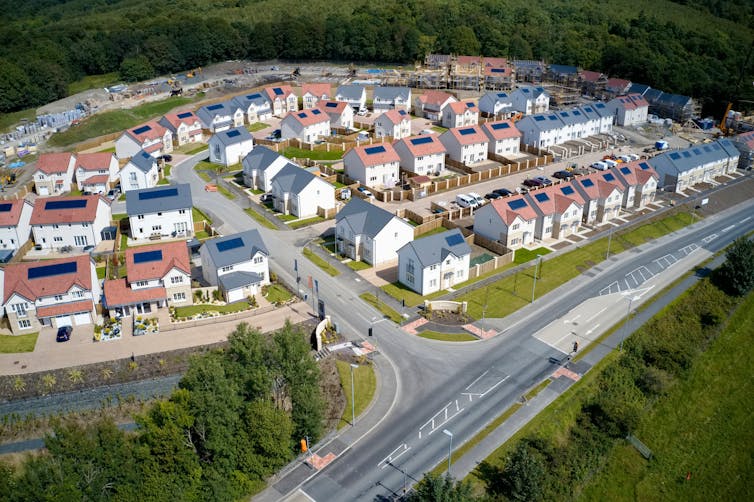At the first UK general election debate between the prime minister, Rishi Sunak, and the leader of the opposition, Keir Starmer, Sunak claimed his government had “delivered 1 million new homes”.
On Tuesday, June 11 2024, Sunak doubled down on this claim, during his speech to launch the Conservative party manifesto. Underlining his party’s plan to “build an ownership society” – a “property-owning democracy” – he further pledged to deliver another 1.6 million homes over the next parliament.
The Conservative manifesto follows suit, emphasising home ownership, with little attention paid to affordable housing and renting. This comes against the backdrop of councils across England rehousing homeless families hundreds of kilometres from their support networks, citing a dire lack of affordable homes.

Want more election coverage from The Conversation’s academic experts? Over the coming weeks, we’ll bring you informed analysis of developments in the campaign and we’ll fact check the claims being made.
Sign up for our new, weekly election newsletter, delivered every Friday throughout the campaign and beyond.
The question then is to what extent the Conservatives’ proposals address the housing crisis and whether their track record backs up claims of their achievements to date.
According to government data on net additional dwellings (which shows all new homes, including new builds and conversions), between the last general election in December 2019 and April 2023 (which is as recent as the data goes), 935,200 homes appear to have been added. The total since Sunak took office probably now exceeds 1 million net additional dwellings.
Other government data on permanent new dwellings shows only 675,590 new homes completed over the same 2019-23 period. The mismatched tally is partly due to the different ways the data was collected.
It is also because “net additional dwellings” refers to more than just new-build homes. It includes housing created through change of use (such as offices converted to housing) and conversions (such as subdividing an existing house into flats) and lots of potential dwellings that are developed but then not used as permanent homes – such as short-term lets and student accommodation.
This raises the question of what counts as a new home.

The second question is whether the government can truthfully claim to have “delivered” these new homes.
Still, more government data shows that “private enterprise” has delivered 81% of new housing between 2019-23 (with the rest from housing associations and local authorities). Even the government’s Homes England agency says that it doesn’t actually build any housing, instead, it helps others to do this.
Some elements of government policy may well have helped to facilitate this housing, but other elements have not. Reforms in recent years have actually seen more low- quality housing be developed.
Under permitted development deregulation, it has become easier to convert offices to residential use. My colleagues and I have shown how this has led to buildings ill-suited to residential needs. The potential health and wellbeing implications for residents can then translate into costs for the NHS.
The biggest question is whether this level of new housing supply is enough.
The Conservatives have often said they will build 300,000 new homes across England per year. This would have meant about 1.35 million homes under the current government – not just 1 million apparently delivered. Sunak has admitted as much, saying in a recent interview that it has actually got harder to own a home under his government. This might explain why the manifesto promises to deliver 1.6 million homes over the next parliament.
Quite what is enough though, in terms of housing supply, is more complex than is often claimed. That is because the housing crisis is multifaceted.
Read more: The UK's coastal 'ghost enclaves' are the result of government failure on low-use homes
Headline figures across England ignore significant variation from region to region. In some places, such as London, there is a large shortfall of homes, compared with need, in some places. But this is not the case everywhere.
This demand side of the housing crisis is overlooked. Research from Ireland even shows that increasing housing supply can be associated with rising housing costs.
Some housing scholars point out that the housing crisis is more accurately described as one of affordability. The current Conservative government has certainly failed to make enough homes available for low-income households.
Government data on new-build housing completions overlooks the many ways local authorities are starting to directly provide housing again. However, the fact that most authorities across the country now prioritise increasing affordable housing shows how pressing the crisis is.
Recent government reforms have tended simply to increase the profits of large volume private sector housebuilders. They have not focused on making housing more affordable.
This is only reinforced by the strong emphasis the manifesto places on home ownership. The Conservatives promise to relax stamp duty for first-time home buyers and implement a new Help to Buy scheme, while maintaining green-belt protections.
Read more: Affordable housing is a myth that worsens the housing crisis – but there is a fix
This is likely to increase demand but not supply. It is unlikely to improve housing affordability. Certainly, the previous iteration of Help to Buy actually seems to have made housing more expensive.
Elsewhere, the manifesto simply promises to continue the existing Affordable Homes Programme (through which Homes England and the mayor of London support affordable housing provision by providing grant funding to housing associations and local authorities). This is important funding. But it has failed to deliver anything like the amount of genuinely affordable housing needed. Recent research identifies a need for 145,000 new affordable homes each year but in 2022-23 only 63,605 such homes were delivered in England.
More social homes were lost than built due to Right to Buy. In continuing this scheme and enforcing restrictions on how local authorities can use the income from it, the government has been undermining local authority aspirations to build more social housing.
Of further concern is the manifesto’s promise to remove EU rules preventing pollution from new house-building projects. But without infrastructure upgrades, more homes will lead to more sewage ending up in more rivers.
People need good quality, affordable housing. And they need it to be built in the right places. The current government’s record on this can only be described as poor. The 2024 manifesto offers little hope that a future Conservative government will do better.

